The article below was published immediately after a visit to the garden in 2012. The following link leads to an October 5, 2015, article by Jack Morgan of KSTX San Antonio. The article in turn includes links leading to more information on the garden and on Japanese Gardening dot org.
http://tpr.org/post/incredible-story-behind-san-antonios-japanese-tea-garden#stream/0
In Texas, when I said, “We’ve been to a Japanese garden in San Antonio,” many people thought I was referring to the Japanese Tea Garden at Sunken Gardens, Brackenridge Park. I was referring to Kumamoto en, detailed in an earlier post about the San Antonio Botanical Garden.
But there is a story here at Sunken Gardens – another sad story of a family losing their home and livelihood due to fear during World War II and another hopeful story of better things to come.
There are many striking features about this garden – the stonework on paths, benches, structures and ponds alone is worth a visit. Initially, in 1840 the property was a quarry. In 1880, the Alamo Roman and Portland Cement Company constructed the first cement plant west of the Mississippi. A smokestack near a gazebo overlook marks the kiln that was built in 1889.
The story of the garden is told on a 1984 brass plaque adjacent to the entry gate, an unusual torii style structure in the fois bois design bearing the inscription “Chinese Tea Garden.”
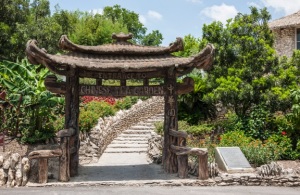
The torii gate created by Dionicio Rodriguez is a national landmark. Text of the plaque at the right is reproduced below.
(photo by Bill F. Eger)
The plaque reads: “The idea of a Japanese tea garden was conceived by City Parks Commissioner Ray Lambert in the early 1900s in an effort to beautify the rock quarries which had earlier been abandoned by the San Antonio Portland Cement Company. The brick and stone smokestack east of the teahouse is part of the old Portland Cement kiln.
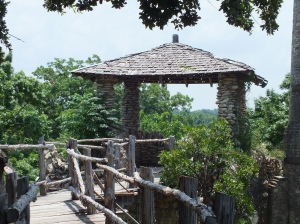
The kiln smokestack at the extreme right of the photo is all that is left of the old cement plant. The gazebo overlook is on the list of things to be refurbished at the Japanese Tea Garden in San Antonio.
“Commissioner Lambert enlisted the aid of a Japanese artist Kimi Eizo Jingu to assist in the design of an authentic Japanese tea garden. Artist Jingu had recently arrived in San Antonio with his family, had been employed by the U.S, Army and was selling his watercolor paintings in a shop in downtown San Antonio.
“The Japanese tea garden was completed and christened in 1919 having been constructed with prison labor and with both corporate and individual donations. Commissioner Lambert had given particular effort to achieving true Japanese design and had imported numerous plants from gardens existing in Japan. A house was constructed on the site using rocks from the old quarry, and the Jingu family was moved into the house to act as overseers for the facility. In 1926, the Jingus opened a tea house in the upper level of their home. Before his death in 1936, Mr. Jingu had become nationally recognized for his knowledge of teas.
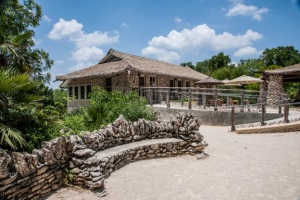
Jingu House Cafe is open Tuesday through Saturday 9 a.m. to 4 p.m. This view shows improvements done recently to allow for barrier-free access.
(photo by Bill F. Eger)
“The Jingu family remained in their home in the garden until shortly after the December 7, 1941, Pearl Harbor incident. The resulting general fear and resentment by the American public caused the Jingu family to be removed from the garden and its name was changed to Chinese Tea Garden.
“It was at this time the Chinese-style entry was added, bearing the inscription ‘Chinese Tea Garden.’ This Oriental-design cement-sculptured entry was purportedly designed by Maximo Cortez and constructed by Dionicio Rodriguez. Mr. Rodrigues was a Mexican national who is credited with a number of cement sculptures in San Antonio. He kept his techniques secret working always inside a tent and using tools he made on the site from tin, wood, etc. His process consisted of a metal rod base on which he developed three-dimensional designs with layers of especially prepared cement. He did not divulge either his process of cement sculpture or coloring of the cement layers. He spoke no English and a few co-workers learned by observation only. He is credited with having created various other sculptures throughout the United States in addition to those in the San Antonio area.
“In 1983, the San Antonio City Council ordained that the original name of “Japanese Tea House” be restored to the site in consideration of the number of Japanese-Americans who had fought honorably on the side of the United States during World War II.”
It should be noted here that the youngest sons James and Kimi Jingu served in the U.S. Army. James received a Purple Heart for his actions with the 442nd in Europe and Kimi served in the Korean conflict. See one newspaper article here: http://www.flickr.com/photos/42448022@N05/3967648434/
Don Pylant notes current happenings in his article
http://www.japanesegardening.org/sunkengardens/index.html
“A move to restore the Japanese Tea Garden came in the 2005 bond election to repair the Pavilion. With help and guidance from San Antonio Parks Foundation and Friends of the Parks, this Phase 1 began. The original roofing was fencing wire with palm leaf thatch, harvested from the city parks, woven together to shed water. The new roof is a fantastic mimic of artificial palm thatch – all the looks without the fire hazard.
“In 2007, former councilwoman Bonnie Conner, Parks Foundation vice chair of projects, and former Mayor Lila Cockrell, Parks Foundation president, began a $1.6 million restoration campaign to repair the lily ponds. The successful effort resulted in the restoration of the ponds, a new re-circulating filtration system, and the return of fish and lilies to the ponds. For the public re-opening on March 8, 2008, Jingu and Lambert family members were present. Mabel Yoshiko Jingu Enkoji, the sixth child of Kimi and Miyoshi Jingu, and born at the Gardens, was the senior Jingu family member at the event. Richard Lambert, grandson of Commissioner Ray Lambert was also present.
“A master plan is being created and fundraising will begin soon to continue the effort to return the Japanese Tea Gardens to its former glory as a jewel in the crown of San Antonio and South Texas.”
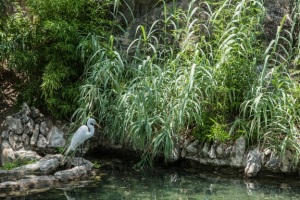
A problem common to all gardens with koi ponds — birds that like to go fishing!
(photo by Bill F. Eger)
Side note: for more on Dionicio Rodriguez and his Trabajo Rustico, see the book Capturing Nature: The Cement Sculpture of Dionicio Rodriguez by Patsy Pittman Light.
Unless otherwise credited, all photos in this blog are by K.T. Cannon-Eger. To see a full size image, click on the photo.

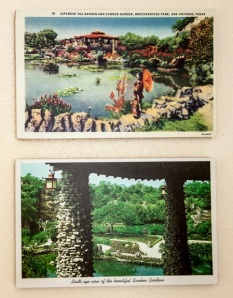
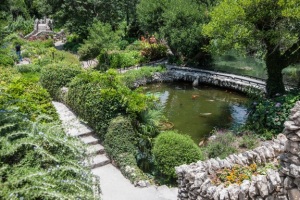
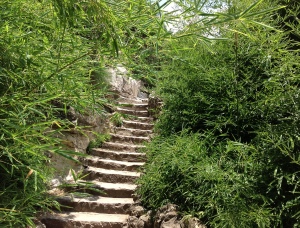
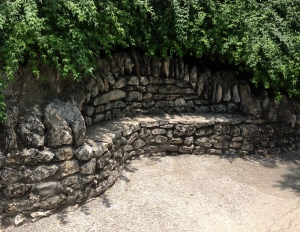
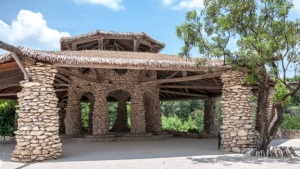
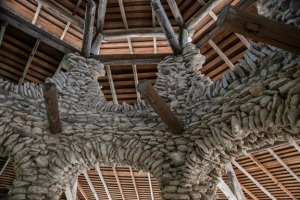
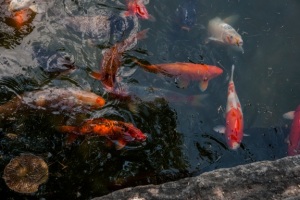
Great post! I’m glad you enjoyed visiting the site and learning about its history. Admittedly the style of the gardens is more sui generis than truly “Japanese,” but I agree with you that the story of the Jingu family is an important one for us to remember and learn from. And, of course, the restored gardens are lovely and the green tea cookies at the lunchroom very tasty. Thanks for a very well-written and researched post, and good luck on the rest of your trip! –Leilah Powell, Executive Director, Brackenridge Park Conservancy
Thank you Leilah for your kind remarks. We enjoyed our time at Sunken Gardens quite a bit. In particular, your fish are outstanding.
Thank you Leilah Powell. It was a treat to visit in the company of Don Pylant who transmitted his love of the gardens and restaurant to us.